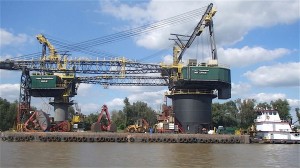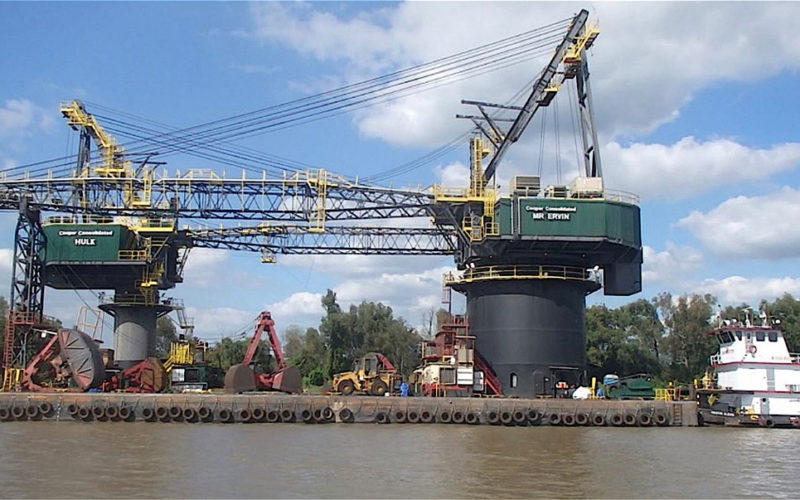
Kristin Alexis approached the west span of the Sunshine Bridge near St. James, La., pushing the crane barge Mr. Ervin. The pilot at the controls of the towboat assumed the crane standing 136 feet over the water would pass under with room to spare.
Moments later, at 0141 on Oct. 12, 2018, the crane’s A-frame struck the highway bridge at mile 167.4 on the Lower Mississippi River. No one was injured and no pollution was reported, but the impact caused extensive structural damage to the bridge. It closed for seven weeks and required almost $7 million in repairs.
National Transportation Safety Board (NTSB) investigators honed in on the pilot’s decision to pass under the bridge’s west span (west section) instead of the channel span with a higher vertical clearance. They identified flaws in the voyage plan, the watch turnover briefing, and the crew’s decision to get underway despite concerns about a seriously obstructed view.
The agency’s report noted shortcomings with vessel operator Marquette Transportation’s internal practices and safety management system (SMS). It also noted that National Oceanic and Atmospheric Administration (NOAA) charts used by the pilot on his approach did not provide accurate vertical clearance for the west span.
“Investigators believe that proper voyage planning and accurate overhead clearance calculations would have shown that the west span was not transitable with the crane barge,” the NTSB said in its report.
Based on these findings, the NTSB called on NOAA to update bridge data and charts to include vertical clearance for all navigable bridge spans. It urged Marquette Transportation to audit to make sure crews understand bridge transit and watch turnover procedures.
In a prepared statement, Marquette said it has updated its SMS and operating processes to clarify voyage planning requirements and the forms its crews must fill out. The company also said it has stepped up its training and internal assessments.
Marquette argued, however, that company policies already in place should have prevented the incident. The statement suggested that blame lies with the captain and pilot aboard the 2,880-hp Kristin Alexis.
“We share the NTSB’s opinion that, given the concerns the captain and pilot had with the restricted visibility resulting from the placement of the crane’s bucket on the barge, they should have exercised their stop work responsibility, as required by Marquette policy,” the company said.
Kristin Alexis, built in 1978, operated under charter to Cooper Consolidated at the time. It typically performed fleet work and moved barges and crane barges between fleets in the Louisiana towns of Convent and Darrow. It was working at the Convent fleet at mile 161 with six crew when it got an order at about 2300 on Oct. 11 to bring the 191-foot Mr. Ervin upriver to the Darrow fleet at mile 175.
The 62-foot Kristin Alexis faced up to the barge on its port side, a position that offered the best view around the crane pedestal blocking the view to starboard. Even in this position, the towboat captain noticed the crane’s grab bucket obstructing the view ahead. Cooper Consolidated personnel denied his request to relocate the bucket.
Neither the captain nor the pilot knew the crane’s exact air draft or the overhead clearance between the crane and Sunshine Bridge before getting underway at 2350, the report said. The pilot came to the wheelhouse on schedule for his 12-hour watch at midnight. The captain didn’t leave the wheelhouse until 0040.
“During the watch handover, both the captain and the pilot stated that they only discussed the placement and removal of the grab bucket,” the NTSB report said, noting the two normally discussed weather, river conditions, bridge transits and other relevant details. That morning’s briefing, the report said, “was not typical because the captain was still ‘upset’ about the placement of the grab bucket.”
The tow continued upriver at about 4 knots near the right descending bank. It remained on that side of the river as it approached the bridge. The pilot said that position afforded the best visibility. It also allowed for a starboard-to-starboard passage with the downbound towboat Nedra K. just south of the Sunshine Bridge. Nedra K. passed under the channel span, while Kristin Alexis lined up for the west span.
While en route, Kristin Alexis’ pilot relied on the Rose Point electronic charting system (ECS) that used data from NOAA charts. The ECS showed a minimum clearance of 133 feet for both the channel and west spans of the Sunshine Bridge. This clearance is based on river levels at 36 feet, the historic high. The gauge at Donaldsonville, La., showed 18.37 feet on the night of the incident.
“Clearance data issued by the (U.S. Army) Corps of Engineers indicated a minimum vertical clearance of 135 feet for the main span and 111 feet at the west span,” the NTSB report said, noting the much lower clearance for the west span. The agency could not explain the height discrepancies between the two sources.
Kristin Alexis lined up to pass under the center of the 725-foot west span. The tow slid to port, toward the bank, as it approached the bridge, but the pilot remained confident the crane would safely pass under the span. That wasn’t the case.
“About 0141 … the top of the crane’s A-frame struck the lowest horizontal support chord and lateral braces of the west span of the Sunshine Bridge,” the report said.
Authorities later determined the bridge barely escaped a catastrophic failure. It was closed for 49 days, requiring long detours for residents living nearby. Delays continued after the span partially reopened. Repairs totaled $8,500 for the crane and $6.7 million for the bridge.
Marquette’s SMS gives all employees authority to stop work at any time when they see something potentially unsafe. The pilot and captain both told investigators they gave no consideration to exercising that authority.
That part of the SMS was clear, but other policies were not. For instance, the document did not provide clear guidance on calculating overhead clearance, the NTSB said. The SMS also did not contain specific rules for passing under channel spans versus alternate spans. A company port captain later said taking the channel span was a “rule of thumb,” but it was not codified anywhere.
“Had the company shared, in writing, (its) expectation about which span to use when transiting with a crane barge, perhaps the pilot would not have considered using the west span,” the report said.
The checklist for the watch transfer indicated the captain and pilot discussed all items on the list when in fact they did not. The pilot did not contact the port captain upon completing the job safety briefing form after starting his watch. Such a call was required for tows with moderate risks, but the pilot believed it was required only with high-risk tows. Marquette officials pointed to this omission as further evidence that the incident stemmed from crew failures.
“We maintain our belief that if the captain or pilot of the vessel had contacted the Marquette port captain, as required in this situation, the incident would have been prevented,” the company statement said.
Investigators cited crew confusion when completing critical paperwork before the vessel left the dock and after it got underway. The short voyage plan, for instance, contained a space for noting the air draft. But on the night of the accident the captain wrote 37 feet, which corresponded with Kristin Alexis, not Mr. Ervin.
It’s not clear if either the captain or pilot involved in the incident still work for Marquette, which would not answer questions about their employment status. The NTSB did not identify either mariner in its report.

